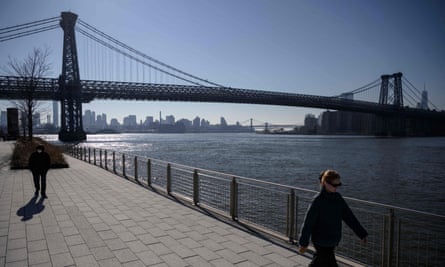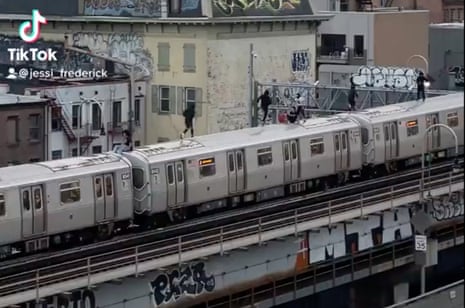The video quickly went viral in June: a group of people dashing across the roof of a moving New York City J train. Captured from far off, the train can be seen about to cross the Williamsburg Bridge, with its 135-foot drop to the East River – yet the daredevils, dressed in black, leap from car to car.
A similar stunt resulted in a far more horrifying clip less than two weeks later, when a 15-year-old boy suffered a severe head injury while riding on top of a 7 train in Queens. Footage reviewed by the Guardian showed first responders hoisting the profusely bleeding teen off the roof and laying him on the floor with part of his skull separated.
Another view! pic.twitter.com/ejil5xrLLu
— kara ☻ (@karasmarsh) June 11, 2022
On Monday, another 15-year-old boy in Queens tried to climb on to the roof of an R train with three friends, only to have his arm severed when he fell on to the tracks and the train ran him over, according to reports.
New Yorkers call it “subway surfing”: a stunt riders have attempted and died from since the transit system’s earliest days, but which has returned as a disturbing trend over the last year among young men and teenage boys who often post the clips online.
According to statistics provided by the Metropolitan Transit Authority, there have already been 627 incidents of people riding outside of trains between January and July this year – up from 96 incidents during the same period last year.
Ken, a Brooklyn resident, told the Guardian he was on an M train last week departing Manhattan’s Delancey-Essex station when a group of about eight boys wearing backpacks, some of whom looked as young as 12, boarded and began “hyping each other up”. Then they used the railings between the subway cars to climb on to the roof as the train chugged over the Williamsburg Bridge.
“Full speed going over the Williamsburg Bridge, we could hear footsteps on top. At times they were running,” he said. “I was quite concerned, obviously: if someone slips and falls, it’s game over.”
Ken said it was “sad seeing their careless attitude toward life, succumbing to peer pressure and doing these incredibly dumb actions.”
A New Yorker in his late 30s called D-Side told the Guardian he had started subway surfing with his friends as a teenager, after he missed his uptown 6 train one day and decided to grab on to the back. The experience was “a rush unlike anything else” and even addicting. “It’s a good feeling, even though it’s completely meaningless. Why does someone skydive? Why does someone use drugs? They like what it makes them feel. And then they keep chasing that over and over again.”
Then tragedy struck D-Side’s best friend, Alex Nasad, a graffiti artist who went by Drone. He was killed in 2002 while he was train surfing an uptown 1 train and apparently hit a support beam. “I think he was just shit-faced drunk. It was like: ‘Oh shit, look, I could go get a rush.’”

D-Side swore off train surfing after Nasad’s death. “A lot of people I know who I told this to are dead right now. So I don’t have clearcut answers to how we stop people from doing this.”
The act of train surfing dates back more than a century in New York City. Local newspaper archives mention people getting maimed or killed riding on top of trains as early as 1904 – the year the subway opened – when two boys, 13 and 14, were struck by a low bridge while riding on top of a Grand Central-bound railcar, killing one of them and injuring the other. One thing seems constant throughout the decades: the victims are young, male and impulsive. As a 1991 story in the New York Times about subway surfing put it, the “risk is the lure”.
In 2016, a 25-year-old Instagram star was killed while trying to subway surf in Brooklyn, while apparently intoxicated. A Bronx subway surfer in his 30s was killed in 2017 after falling off and getting run over. In 2018, a 24-year-old man was electrocuted after standing on top of a commuter train following a Yankees game. In 2019, a 14-year-old boy named Eric Rivera was killed while surfing a 7 train. “I can’t believe that you would risk your life to do that,” his mother told the local outlet the City at the time. “What’s the joy of it, what’s the fun of it? I don’t see it.” Last October, a 32-year-old man was killed while subway surfing when he fell on to the tracks and was run over by the J train.
There may be few more familiar with the stunt’s consequences than the doctors who treat its victims. A physician at a major trauma hospital in New York who asked to remain anonymous recalled treating a train surfer who had gruesome head injuries. Other physicians at the hospital were “pretty judgy” about the victim, the physician said. “The usual response is, ‘Wow, what a stupid thing to do.’
“That’s what emergency care is for, I guess,” the physician added. “People live their crazy lives and we’ll always be here to witness it.”
The MTA’s chief safety and security officer, Patrick Warren, said in an emailed statement: “Riding outside of subway cars is reckless and extremely dangerous. This behavior can result in awful consequences, as it likely has for the young man who was severely injured on Monday.” The MTA’s fine for riding outside of the train is $75.
New York’s train surfing casualties mirror a growing global trend of injuries and deaths from social media-related stunts, as app algorithms reward users for producing extreme content, sometimes as part of viral “challenges”. D-Side believes the return of train surfing is “100%” correlated to social media usage, which has intensified people’s craving for attention. “It’s a hive mind. People chase clout. They care about other people’s opinions. They care about being somebody making a name for themselves. It breeds people wanting things right now.”
Today he’s a father who no longer chases adrenaline. “The thrill I seek now is just watching my kids grow,” he said. “Honestly, I feel lucky to be here.”
